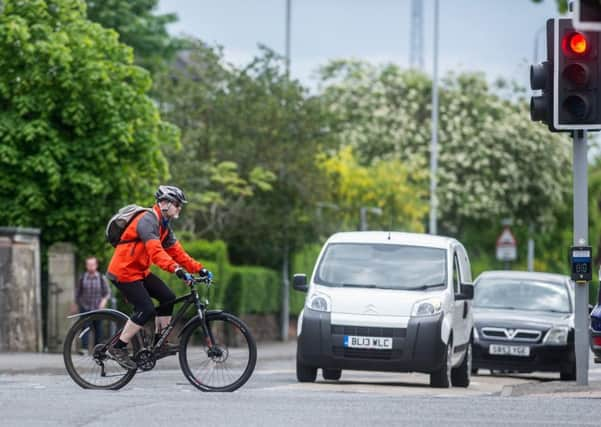Revealed: 20 black spots for cycling accidents


Streets in Paisley, Erskine in Renfrewshire and Wallyford in East Lothian are the country’s most dangerous, according to research by cycle path developers Sustrans.
The highest number of collisions occurred in Edinburgh, but the risk there was rated lower because of the greater number of cyclists.
Advertisement
Hide AdAdvertisement
Hide AdCycles account for about 10 per cent of traffic in Edinburgh compared to 1 to 2 per cent in most other areas.
Sustrans said it showed there was safety in numbers for cycling because it made drivers more aware of them.
It said doubling cycling led to a reduction in the risks of cycling by around one third.
The research, to be presented at the Scottish Transport Applications and Research conference in Glasgow on Wednesday, collated collisions between 2005 and 2014.
The hotspots were ranked by taking into account the number of people who cycled in the area and road safety improvements over the years.
All but one of the top 20 were at or adjacent to junctions, including eight at roundabouts and seven at T or staggered junctions.
The A761 junction with Arkleston Road in Paisley, which had three collisions over the period, was ranked the most risky.
That was followed by the A726/Parkway roundabout in Erskine (four) and the A199/B1361/A6094 roundabout in Wallyford (three). Edinburgh had the most locations in the table – at the Drumbrae roundabout on the A8 in Corstorphine (eight collisions), the A7/Craigmillar Castle Road junction beside Edinburgh Royal Infirmary (seven), the A70/Juniper Avenue junction in Juniper Green (three) and the Burdiehouse Road/Straiton Road/Lang Loan roundabout beside the Straiton junction on the city bypass (three).
Advertisement
Hide AdAdvertisement
Hide AdAll were in the Central Belt apart from one each in Dundee, Perth and Inverness.
Sustrans Scotland national director John Lauder, above, said: “Safety is often cited as the main reason why people don’t cycle for more of the journeys they make every day.
“This research highlights the importance of having high-quality cycling infrastructure in place at junctions, so that collisions can be prevented.
“We know better cycle infrastructure increases the feeling of safety and ultimately the number of people on bikes. The more people in a place who cycle, the safer it becomes for everyone.”
However, Sustrans said Transport Scotland’s plans to upgrade the Sheriffhall roundabout on the Edinburgh city bypass would discourage cycling.
However, the Scottish Government agency said the scheme would “improve access for pedestrians and cyclists compared to the existing arrangement”.
Cyclists were also a “key priority” in its road safety plans.
A spokeswoman for the agency said: “We welcome this latest research from Sustrans, which provides us with information to help make our roads and cycle network safer. It is not surprising Edinburgh is high on the list of collision hotspots as it has the highest levels of cycling in Scotland.
Advertisement
Hide AdAdvertisement
Hide Ad“We continue to work with Sustrans to tackle dangerous roundabouts and junctions through the Community Links and Street Design projects, both funded by Scottish Government.
An Edinburgh City Council spokeswoman said: “We have looked at long-term trends for cyclist casualties in the city, which show the risk of being involved in an accident per mile travelled by bike has fallen significantly over the past 25 years.
“Working with Sustrans, we’re installing protected cycle tracks on a section of Leith Walk as well as improving the junction for cyclists at Macdonald Road.
“Other investments to improve safety include protecting on-street routes, new crossings and bike awareness training for our HGV drivers.”